- Home
- Carl Sagan
Dragons of Eden Page 20
Dragons of Eden Read online
Page 20
If this is so, the same evolutionary winnowing must have occurred on other worlds that have evolved intelligent beings. Extraterrestrial intelligences that lack avian or arboreal ancestors may not share our passion for space flight. But all planetary atmospheres are relatively transparent in the visible and radio parts of the spectrum—because of the quantum mechanics of the cosmically most abundant atoms and molecules. Organisms throughout the universe should therefore be sensitive to optical and/or radio radiation, and, after the development of physics, the idea of electromagnetic radiation for interstellar communication should be a cosmic commonplace—a convergent idea evolving independently on countless worlds throughout the galaxy after the local discovery of elementary astronomy, what we might call the facts of life. If we are fortunate enough to make contact with some of those other beings, I think we will find that much of their biology, psychology, sociology and politics will seem to us stunningly exotic and deeply mysterious. But I suspect we will have little difficulty in understanding each other on the simpler aspects of astronomy, physics, chemistry and perhaps mathematics.
I would certainly not expect their brains to be anatomically or physiologically or perhaps even chemically close to ours. Their brains will have had different evolutionary histories in different environments. We have only to look at terrestrial beasts with substantially different organ systems to see how much variation in brain physiology is possible. There is, for example, an African fresh-water fish, the Mormyrid, which often lives in murky water where visual detection of predators, prey or mates is difficult. The Mormyrid has developed a special organ which establishes an electric field and monitors that field for any creatures traversing it. This fish possesses a cerebellum that covers the entire back of its brain in a thick layer reminiscent of the neocortex of mammals. The Mormyrids have a spectacularly different sort of brain, and yet in the most fundamental biological sense they are far more closely related to us than any intelligent extraterrestrial beings.
The brains of extraterrestrials will probably have several or many components slowly accreted by evolution, as ours have. There may still be a tension among their components as among ours, although the hallmark of a successful, long-lived civilization may be the ability to achieve a lasting peace among the several brain components. They almost certainly will have significantly extended their intelligence extrasomatically, by employing intelligent machines. But I think it highly probable that our brains and machines and their brains and machines will ultimately understand one another very well.
The practical benefits as well as the philosophical insights likely to accrue from the receipt of a long message from an advanced civilization are immense. But how great the benefits and how fast we can assimilate them depend on the details of the message contents, about which it is difficult to make reliable predictions. One consequence, however, seems clear; the receipt of a message from an advanced civilization will show that there are advanced civilizations, that there are methods of avoiding the self-destruction that seems so real a danger of our present technological adolescence. Thus the receipt of an interstellar message would provide a very practical benefit that in mathematics is called the existence theorem—in this case the demonstration that it is possible for societies to live and prosper with advanced technology. Finding a solution to a problem is helped enormously by the certain knowledge that a solution exists. This is one of many curious connections between the existence of intelligent life elsewhere and the existence of intelligent life on Earth.
While more rather than less knowledge and intelligence seems so clearly the only way out of our present difficulties and the only aperture to a significant future for mankind (or indeed to any future at all), this is not a view always adopted in practice. Governments often lose sight of the difference between short-term and long-term benefits. The most important practical benefits have come about from the most unlikely and apparently impractical scientific advances. Radio is today not only the prime channel in the search for extraterrestrial intelligence, it is the means by which emergencies are repsonded to, news is transmitted, telephone calls relayed and global entertainment aired. Yet radio came about because a Scottish physicist, James Clerk Maxwell, invented a term, which he called the displacement current, in a set of partial differential equations now known as Maxwell’s equations. He proposed the displacement current essentially because the equations were aesthetically more appealing with it than without it.
The universe is intricate and elegant. We wrest secrets from nature by the most unlikely routes. Societies will, of course, wish to exercise prudence in deciding which technologies—that is, which applications of science—are to be pursued and which not. But without funding basic research, without supporting the acquisition of knowledge for its own sake, our options become dangerously limited. Only one physicist in a thousand need stumble upon something like the displacement current to make the support of all thousand a superb investment for society. Without vigorous, farsighted and continuing encouragement of fundamental scientific research, we are in the position of eating our seed corn: we may fend off starvation for one more winter, but we have removed the last hope of surviving the following winter.
The plaque aboard the Pioneer 10 and 11 spacecraft, the first vehicles of mankind to venture into interstellar space. The 6-by-9-inch gold anodized aluminum plaques convey, in what is hoped is easily understood scientific language, some information on the locale, epoch, and nature of the builders of the spacecraft. Interstellar radio messages can be much richer in information content than this message in a bottle cast into the cosmic ocean.
In a time in some respects similar to our own, St. Augustine of Hippo, after a lusty and intellectually inventive young manhood, withdrew from the world of sense and intellect and advised others to do likewise: “There is another form of temptation, even more fraught with danger. This is the disease of curiosity. … It is this which drives us on to try to discover the secrets of nature, those secrets which are beyond our understanding, which can avail us nothing and which men should not wish to learn.… In this immense forest, full of pitfalls and perils, I have drawn myself back, and pulled myself away from these thorns. In the midst of all these things which float unceasingly around me in everyday life, I am never surprised at any of them, and never captivated by my genuine desire to study them.… I no longer dream of the stars.” The time of Augustine’s death, 430 A.D., marks the beginning of the Dark Ages in Europe.
In the last chapter of The Ascent of Man Bronowski confessed himself saddened “to find myself suddenly surrounded in the West by a sense of terrible loss of nerve, a retreat from knowledge.” He was talking, I think, partly about the very limited understanding and appreciation of science and technology—which have shaped our lives and civilizations—in public and political communities; but also about the increasing popularity of various forms of marginal, folk- or pseudo-science, mysticism and magic.
There is today in the West (but not in the East) a resurgent interest in vague, anecdotal and often demonstrably erroneous doctrines that, if true, would be-token at least a more interesting universe, but that, if false, imply an intellectual carelessness, an absence of toughmindedness, and a diversion of energies not very promising for our survival. Such doctrines include astrology (the view that which stars, one hundred trillion miles away, are rising at the moment of my birth in a closed building affect my destiny profoundly); the Bermuda Triangle “mystery” (which holds in many versions that an unidentified flying object lives in the ocean off Bermuda and eats ships and airplanes); flying saucer accounts in general; the belief in ancient astronauts; the photography of ghosts; pyramidology (including the view that my razor blade stays sharper within a cardboard pyramid than within a cardboard cube); Scientology; auras and Kirlian photography; the emotional lives and musical preferences of geraniums; psychic surgery; flat and hollow earths; modern prophecy; remote cutlery warping; astral projections; Velikovskian catastrophism; Atlantis and Mu; spiritualism; and t
he doctrine of the special creation, by God or gods, of mankind despite our deep relatedness, both in biochemistry and in brain physiology, with the other animals. It may be that there are kernels of truth in a few of these doctrines, but their widespread acceptance betokens a lack of intellectual rigor, an absence of skepticism, a need to replace experiments by desires. These are by and large, if I may use the phrase, limbic and right-hemisphere doctrines, dream protocols, natural—the word is certainly perfectly appropriate—and human responses to the complexity of the environment we inhabit. But they are also mystical and occult doctrines, devised in such a way that they are not subject to disproof and characteristically impervious to rational discussion. In contrast, the aperture to a bright future lies almost certainly through the full functioning of the neocortex—reason alloyed with intuition and with limbic and R-complex components, to be sure, but reason nonetheless: a courageous working through of the world as it really is.
It is only in the last day of the Cosmic Calendar that substantial intellectual abilities have evolved on the planet Earth. The coordinated functioning of both cerebral hemispheres is the tool Nature has provided for our survival. We are unlikely to survive if we do not make full and creative use of our human intelligence.
“We are a scientific civilization,” declared Jacob Bronowski. “That means a civilization in which knowledge and its integrity are crucial. Science is only a Latin word for knowledge.… Knowledge is our destiny.”
Acknowledgments
TO WRITE A BOOK on a subject so far from one’s primary training is at best incautious. But, as I have tried to explain, the temptation was irresistible. Whatever virtues this book may have are largely thanks to those who performed the fundamental research described, and to those professionals in the biological and social sciences who were kind enough to read and react to my arguments. I am indebted for critical comments and stimulating discussions to the late L. S. B. Leakey and Hans-Lukas Teuber, to Joshua Lederberg, James Maas, John Eisenberg, Bernard Campbell, Lester and David Grinspoon, Stephen Jay Gould, William Dement, Geoffrey Bourne, Philip Morrison, Charles Hockett, Ernest Hartmann, Richard Gregory, Paul Rozin, Jon Lomberg, Timothy Ferris, and particularly to Paul MacLean. I appreciate the painstaking care which several of them, as well as editor Anne Freedgood and copy editor Nancy Inglis, both at Random House, took in reading earlier drafts of this book. They are, it is probably unnecessary to add, not to be held responsible for my speculations or for any errors which may be found herein. I am grateful to Linda Sagan and Sally Forbes for picture research; to several colleagues for preprints of scientific reports in advance of publication; and to Don Davis for the cover painting, which is intended not as a literal depiction of any particular epoch in Earth history, but as a metaphor of a few of the ideas set forth above. Some of this work was made possible by the institution of sabbatic leave at Cornell University. I am also grateful for their kind hospitality to L. E. H. Trainor, M. Silverman, C. Lumsden and Andrew Baines, Principal of New College, all affiliated with the University of Toronto. Substantial parts of Chapter 1 appeared in the magazine Natural History. Some of the ideas in this book were first presented at a joint colloquium of the Massachusetts Mental Health Center and Harvard University Medical School’s Department of Psychiatry, and at an L. S. B. Leakey Foundation lecture at the California Institute of Technology. The production of this book owes much to the typing skills of Mary Roth and, especially, to the dedicated transcription and retyping through many drafts by Shirley Arden.
Bibliography
ALLISON, T., and D. V. CICCHETTI. “Sleep in Mammals: Ecological and Constitutional Correlates.” Science, Vol. 149, pp. 732–734, 1976.
AREHART-TREICHEL, JOAN. “Brain Peptides and Psychopharmacology.” Science News, Vol. 110, pp. 202–206, 1976.
ARONSON, L. R., E. TOBACH, LEHRMAN, D. S., and J. S. ROSENBLATT, eds. Development and Evolution of Behavior: Essays in Memory of T. C. Schneirla. W. H. Freeman, San Francisco, 1970.
BARKER, ROBERT T. “Dinosaur Renaissance.” Scientific American, Vol. 232, pp. 58–72 et seq., April 1975.
BITTERMAN, M. E. “Phyletic Differences in Learning.” American Psychologist, Vol. 20, pp. 396–410, 1965.
BLOOM, F., D. SEGAL, N. LING and R. GUILLEMIN. “Endorphins: Profound Behavioral Effects in Rats Suggest New Etiological Factors in Mental Illness.” Science, Vol. 194, pp. 630–632, 1976.
BOGEN, J. E. “The Other Side of the Brain. II. An Appositional Mind.” Bulletin Los Angeles Neurological Societies, Vol. 34, pp. 135–162, 1969.
BRAMLETTE, M. N. “Massive Extinctions in Biota at the End of Mesozoic Time.” Science, Vol. 148, pp. 1696–1699, 1965.
BRAND, STEWART. Two Cybernetic Frontiers. Random House, New York, 1974.
BRAZIER, M. A. B. The Electrical Activity of the Nervous System. Macmillan, New York, 1960.
BRONOWSKI, JACOB. The Ascent of Man. Little, Brown, Boston, 1973.
BRITTEN, R. J., and E. H. DAVIDSON. “Gene Regulation for Higher Cells: A Theory.” Science, Vol. 165, pp. 349–357, 1969.
CLARK, W. E. LEGROS. The Antecedents of Man: An Introduction to the Evolution of the Primates. Edinburgh University Press, Edinburgh, 1959.
COLBERT, EDWIN. Dinosaurs: Their Discovery and Their World. E. P. Dutton, New York, 1961.
COLE, SONIA. Leakey’s Luck: The Life of Louis S. B. Leakey. Harcourt Brace Jovanovich, New York, 1975.
COPPENS, YVES. “The Great East African Adventure.” CNRS Research, Vol. 3, No. 2, pp. 2–12, 1976.
COPPENS, YVES, F. CLARK HOWELL, GLYNN LL. ISAAC, and RICHARD E. F. LEAKEY, eds. Earliest Man and Environments in the Lake Rudol Basin: Stratigraphy, Palaeoecology and Evolution. University of Chicago Press, Chicago, 1976.
CULLITON, BARBARA J. “The Haemmerli Affair: Is Passive Euthanasia Murder?” Science, Vol. 190, pp. 1271–1275, 1975.
CUTLER, RICHARD G. “Evolution of Human Longevity and the Genetic Complexity Governing Aging Rate.” Proceedings of the National Academy of Sciences, Vol. 72, pp. 4664–4668, 1975.
DEMENT, WILLIAM C. Some Must Watch While Some Must Sleep. W. H. Freeman, San Francisco, 1974.
DERENZI, E., FAGLIONI, P., and H. SPINNLER. “The Performance of Patients with Unilateral Brain Damage on Face Recognition Tasks.” Cortex, Vol. 4, pp. 17–34, 1968.
DEWSON, J. H. “Preliminary Evidence of Hemispheric Asymmetry of Auditory Function in Monkeys.” In Lateralization in the Nervous System, S. Hamad, ed. Academic Press, New York, 1976.
DIMOND, STEWART, LINDA FARRINGTON and PETER JOHNSON. “Differing Emotional Responses from Right and Left Hemispheres.” Nature, Vol. 261, pp. 690–692, 1976.
DIMOND, S. J., and J. G. BEAUMONT, eds. Hemisphere Function in the Human Brain. Wiley, New York, 1974.
DOBZHANSKY, THEODOSIUS. Mankind Evolving: The Evolution of the Human Species. Yale University Press, New Haven, Conn., 1962.
DOTY, ROBERT W. “The Brain.” Britannica Yearbook of Science and the Future, Encyclopaedia Britannica, Chicago, 1970, pp. 34–53.
ECCLES, JOHN C. The Understanding of the Brain. McGraw-Hill, New York, 1973.
ECCLES, JOHN C., ed., Brain and Conscious Experience. Springer-Verlag, New York, 1966.
EIMERL, SAREL, and IRVEN DEVORE. The Primates. Life Nature Library, Time, Inc., New York, 1965.
FARB, PETER. Man’s Rise to Civilization as Shown by the Indians of North America from Primeval Times to the Coming of the Industrial State. E. P. Dutton, New York, 1968.
FINK, DONALD G. Computers and the Human Mind: An Introduction to Artificial Intelligence. Doubleday Anchor Books, New York, 1966.
FRISCH, JOHN H. “Research on Primate Behavior in Japan.” American Anthropologist, Vol. 61, pp. 584–596, 1959.
FROMM, ERICH. The Forgotten Language: An Introduction to the Understanding of Dreams, Fairy Tales and Myths. Grove Press, New York, 1951.
GALIN, D., and R. ORNSTEIN. “Lateral Specialization of Cognitive Mode: An EEG Study.” Psychophysiology, Vol. 9, pp. 412–418, 1972.
GANTT, ELIZABETH. “Phycobilisomes: Light-Harvesting Pigment Complexes.” Bioscience, Vol. 25, pp. 781–788, 1975.
GARDNER, R. A., and BEATRICE T. GARDNER. “Teaching Sign-Language to a Chimpanzee.” Science, Vol. 165, pp. 664–672, 1969.
GAZZANIGA, M. S. “The Split Brain in Man.” Scientific American, Vol. 217, pp. 24–29, 1967.
GAZZANIGA, M. S. “Consistency and Diversity in Brain Organization.” Proceedings Conference on Evolution and Lateralization of the Brain, Annals of the New York Academy of Sciences, 1977.
GERARD, RALPH W. “What Is Memory?” Scientific American, Vol. 189, pp. 118–126, September 1953.
GOODALL, JANE. “Tool-Using and Aimed Throwing in a Community of Free-Living Chimpanzees.” Nature, Vol. 201, pp. 1264–1266, 1964.
GOULD, STEPHEN JAY. “This View of Life: Darwin’s Untimely Burial.” Natural History, Vol. 85, pp. 24–30, October 1976.
GRAY, GEORGE W. “The Great Ravelled Knot.” Scientific American. Vol. 179, pp. 26–39, October 1948.
GRIFFITH, RICHARD M., MIYAGI, OTOYA, and TAGO, AKIRA. “The Universality of Typical Dreams: Japanese vs. Americans.” American Anthropologist, Vol. 60, pp. 1173–1179, 1958.
GRINSPOON, LESTER, EWALT, J. R., and R. L. SCHADER. Schizophrenia: Pharmacotherapy and Psychotherapy. Williams & Wilkins: Baltimore, 1972.
HAMILTON, C. R. “An Assessment of Hemispheric Specialization in Monkeys.” Proceedings Conference on Evolution and Lateralization of the Brain, Annals of the New York Academy of Sciences, 1977.

 Cosmos
Cosmos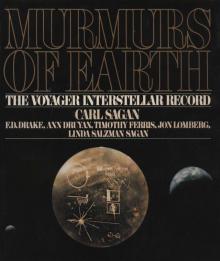 Murmurs of Earth
Murmurs of Earth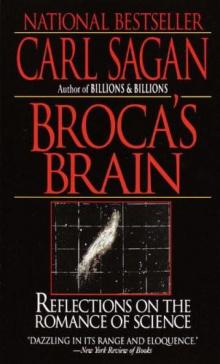 Broca's Brain
Broca's Brain Comet
Comet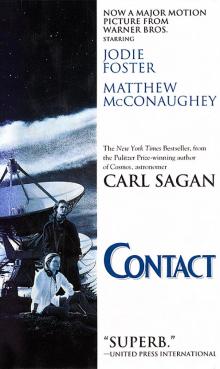 Contact
Contact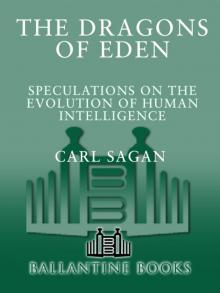 Dragons of Eden
Dragons of Eden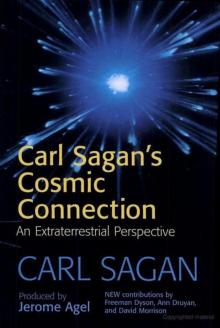 Cosmic Connection
Cosmic Connection Shadows of Forgotten Ancestors
Shadows of Forgotten Ancestors Billions & Billions
Billions & Billions Comet, Revised
Comet, Revised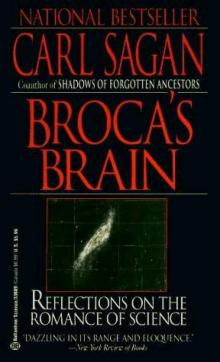 Broca's Brain: The Romance of Science
Broca's Brain: The Romance of Science The Varieties of Scientific Experience: A Personal View of the Search for God
The Varieties of Scientific Experience: A Personal View of the Search for God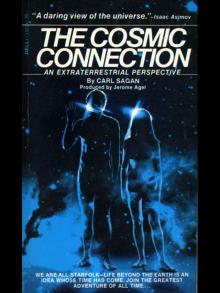 The Cosmic Connection
The Cosmic Connection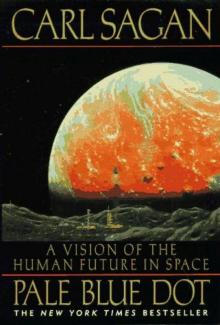 Pale Blue Dot: A Vision of the Human Future in Space
Pale Blue Dot: A Vision of the Human Future in Space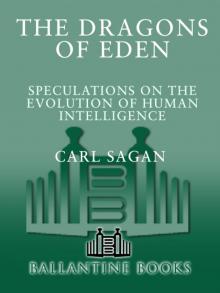 The Dragons of Eden
The Dragons of Eden